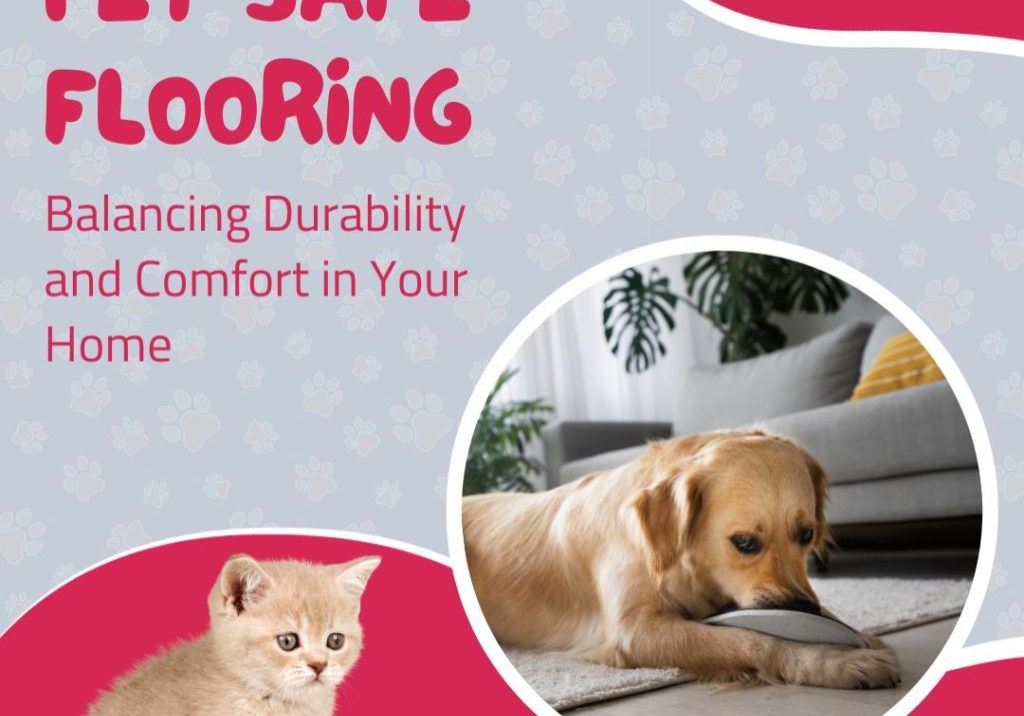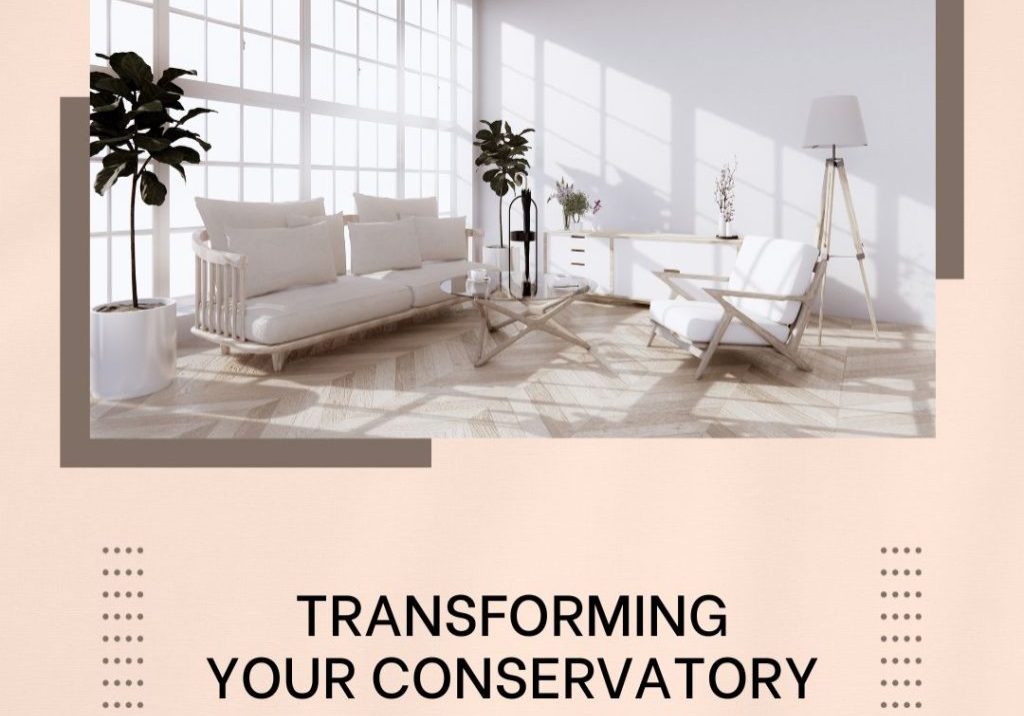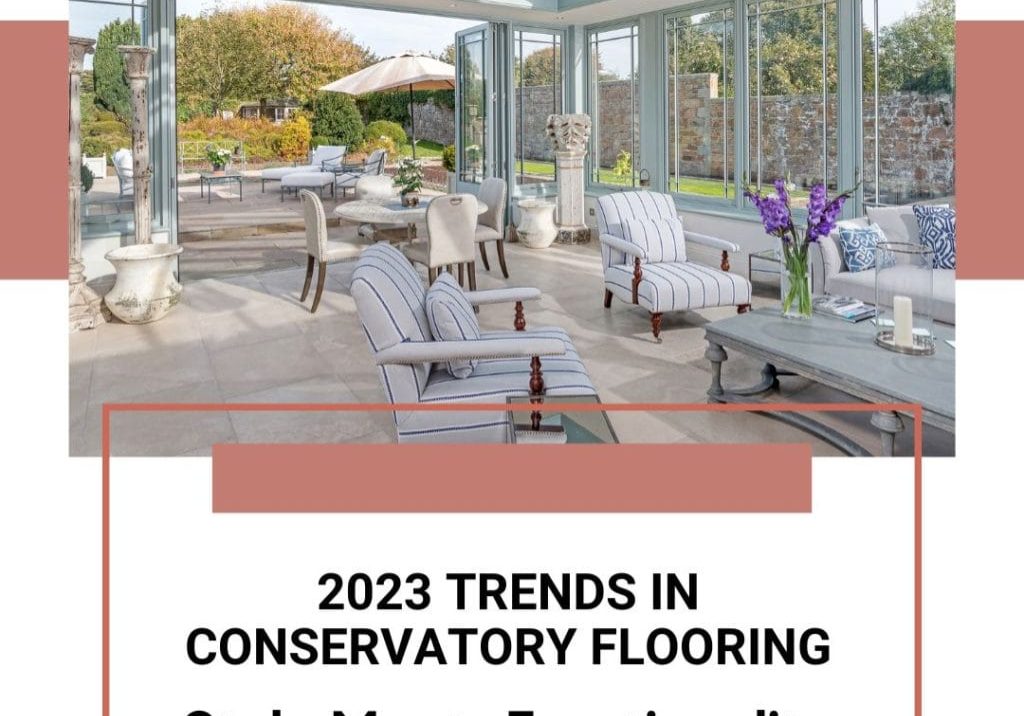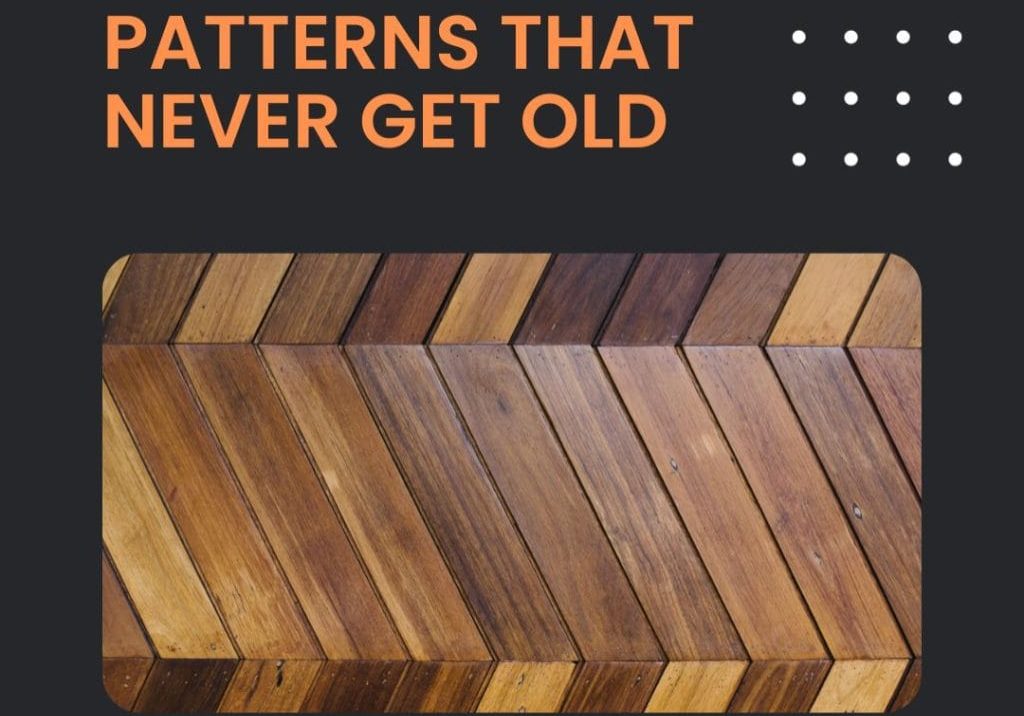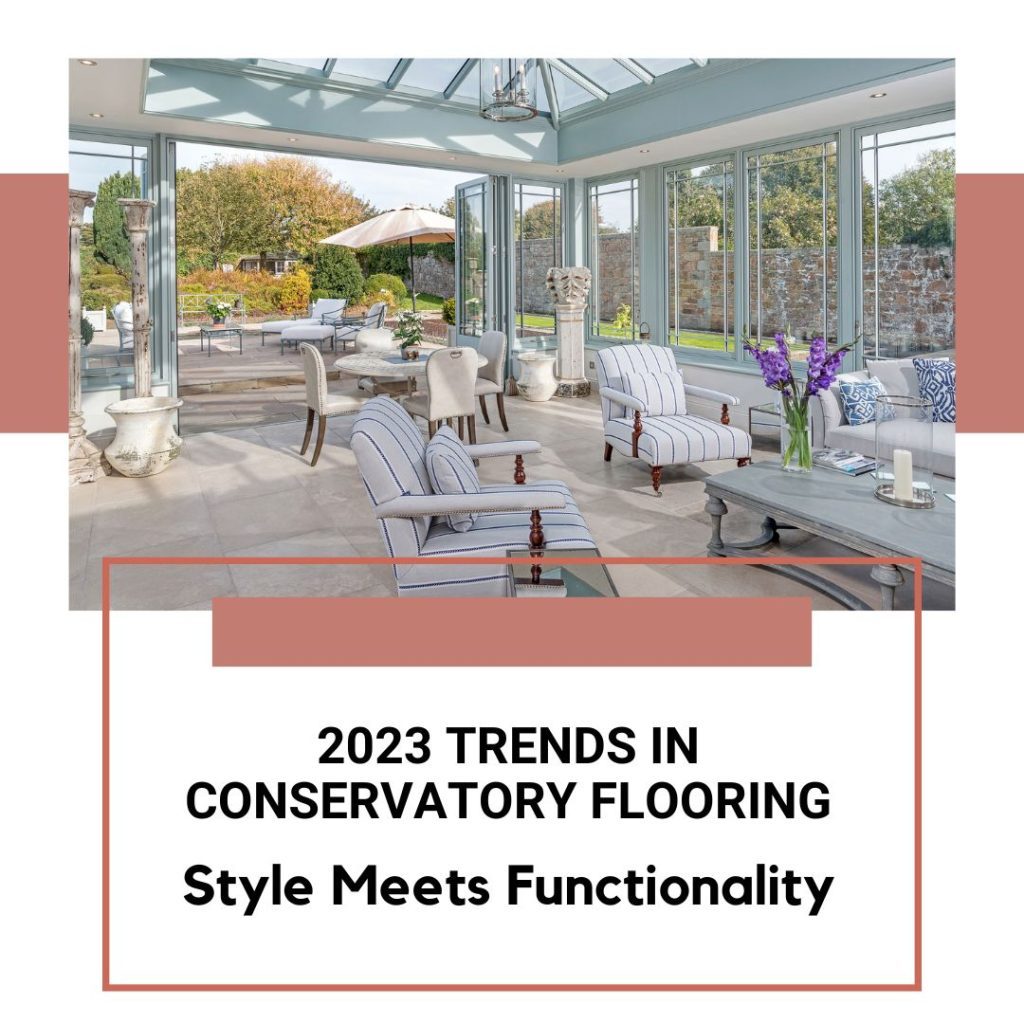With the right ideas for your conservatory floor, you can make the most of every part of your home throughout the year. Concerns about cold and unwelcoming spaces are common when it comes to conservatories. However, with good insulation and practical flooring choices, even an old-fashioned garden room can be transformed into a usable family space.
Whether you’re starting from scratch to create the perfect indoor-outdoor room or seeking ideas to refresh an existing structure, choosing the best flooring for your conservatory is crucial for using the space effectively. From Luxury Vinyl Tiles (LVT) and vinyl to carpet and real wood, we’ve gathered some fantastic ideas and inspiring spaces to help you decide on the best flooring for conservatory.
1. Link the Outside and In with a Wooden Conservatory Floor
With many flooring options available, choosing the right one can be confusing. Wooden floors in a conservatory are a great choice, bringing a natural and warm feel, connecting the indoor space with the outdoors.
There are different types of wood flooring, like solid wood and engineered boards, with various finishes. Your budget and how much maintenance you’re willing to do will help you decide.
As a quick tip, engineered wood flooring is often more stable and budget-friendly than solid wood. Lisa from Vale Garden Houses advises, ‘A well-engineered timber floor will give your room a lovely warm feel and will be relatively stable if well laid. Beware of cheap timber floors that can shrink, move, or warp.
2. Go Rustic with a Classic Stone Floor
Choosing natural stone flooring for your conservatory is a classic and timeless option. While it’s often considered a higher-budget choice, it could be more manageable for a small conservatory, especially when you consider the durability of this material.
There are various natural stone options available, each with different levels of maintenance. However, a natural stone floor has the potential to last for centuries, making it an ideal choice for permanent conservatory structures built with high-quality materials.
3. Choose LVT for Easy Maintenance
Luxury vinyl tile (LVT) flooring presents an attractive option for those seeking an alternative to wood or stone flooring in their conservatory. If your conservatory experiences frequent foot traffic from kids, pets, or muddy boots, LVT offers a hassle-free solution with easy cleaning. Many LVT planks are resistant to stains, scratches, and slips.
With top layers mimicking the look of wood, stone, or marble, you can complement your conservatory’s decor. Stella Coyle, retail sales manager of Karndean Designflooring, notes, ‘Being warm underfoot and compatible with underfloor heating, LVT can be an ideal solution for keeping your conservatory a usable space throughout the year. LVT is also a practical choice for busy modern homes, featuring a hard-wearing, waterproof surface that’s easy to keep hygienically clean.
4. Choose a Floor that Works with Underfloor Heating
One frequent concern with conservatories is their tendency to become too cold in winter, limiting their functionality. However, addressing this issue becomes more feasible when installing new flooring or replacing existing materials by incorporating an underfloor heating (UFH) system along with floor insulation.
While UFH is highly effective with hard floors like stone or tile, it can also be compatible with engineered wood and carpet. However, it’s crucial to ensure that the tog rating of the latter does not exceed 2.5 togs, including the underlay.
5. Install Carpet in a Conservatory Sitting Room for a Soft Finish
Warm and soft underfoot, carpet is not commonly associated with conservatories or sunrooms. However, advancements in stain resistance and overall durability have introduced carpet types that are now a practical choice for garden-facing rooms.
In spaces like this monochromatic conservatory, inviting and stylish small living room ideas may involve using a versatile short pile carpet in a light grey shade to complement the whitewashed exposed brick and timber structure.
“Carpet can be a suitable solution in conservatories that offer additional living space rather than those primarily serving as a thoroughfare to the garden. However, it’s advisable to avoid carpet in conservatories in homes with children and dogs if there’s no alternative access to the patio and outdoor space,” suggests Claire Lloyd, Editor of Homebuilding & Renovating. “Consider incorporating an in-built coir mat near patio doors as a practical addition.”
“Keep in mind that, when exposed to high sunlight levels, the color may fade over time. Therefore, it’s better to opt for more muted colors and neutrals. On the positive side, carpet is generally more forgiving than other floor finishes on uneven subfloor.
6. Opt for a Timeless Tile in a Conservatory
Porcelain tiles are an excellent choice for conservatories for several reasons,” says Abbas Youssefi from Porcelain Superstore. “The color remains unfaded over time, even when exposed to harsh sunlight, which sets it apart from materials like vinyl or carpet.
Moreover, tiles do not crack in freezing temperatures, and they are compatible with underfloor heating, unlike certain other flooring surfaces. Finally, unlike wood, they do not expand or contract with variations in moisture and temperature.
7. Choose Natural Flooring in a Pared-Back Conservatory
Durable and eco-friendly, natural carpets made from sisal, jute, and seagrass offer enduring style and remarkable versatility for conservatory spaces.
Although the coarser texture may deviate from typical living spaces, these carpet types are well-suited for conservatories that connect the garden and interior areas.
In this timeless conservatory, the interior design draws inspiration from the natural carpet, with mismatched seating contributing to a relaxed atmosphere in the white-painted space. Additionally, an excellent illustration of creative conservatory lighting involves incorporating low-hung pendants to establish a central focus for a room usable both day and night.
8. Introduce Flooring that Works for Multiple Spaces in a Conservatory Extension
Many conservatories are distinct from the main living space due to Building Regulations mandating the presence of an external-grade door. However, if you’re contemplating replacing a conservatory with an extension to seamlessly connect a sunlit garden space with an open-plan kitchen or dining area, careful consideration must be given to selecting suitable flooring for the entire area.
Porcelain tiles, excellent for kitchens and dining spaces, are also well-suited for conservatories. “They’re really durable and easy to clean, which is important if you’re walking into the conservatory from the garden with muddy shoes, paws,” adds Abbas Youssefi of Porcelain Superstore.
9. Go Eco with Cork Flooring in a Conservatory
Cork presents a fantastic choice for individuals seeking a sustainable and renewable flooring solution for their conservatory. Beyond being warm underfoot and durable, cork provides natural acoustic insulation, making it an ideal option for a room predominantly comprised of glass!
Eco-friendly flooring options can often be cost-effective for smaller spaces like conservatories, with certain tiles priced as low as £13/m2. In a London extension, cork flooring was employed throughout the layout, requiring sealing to maintain cleanliness and dryness.
10. Introduce a Bold Pattern in a Modern Conservatory
Each corner of your home narrates a tale, and patterned or minimal borders are highly sought after to inject intrigue and outline a conservatory space,” remarks Stella Coyle of Karndean.
When orchestrating a conservatory makeover or new interior design, select one or two colors from the pattern to guide the overall decor, as demonstrated in this contemporarily styled space.
The green hues of the LVT tiles are subtly mirrored in the plant wall, while the black is also incorporated into the lighting, window treatment, and furniture selections.
11. Consider a Luxurious Finish with Marble Flooring
Conservatories are often overlooked in home interior design, but infusing a more daring sense of style can be rewarding.
Marble can be a viable choice for a premium conservatory since its maintenance, especially in terms of cleaning spills, is naturally lower compared to installations in bathrooms or kitchens.
While this material makes a striking impression, its high cost may make it better suited for an orangery or for those contemplating sunroom ideas.
12. Continue Conservatory Flooring Choices Outside
Creating a seamless connection between your conservatory, home, and garden can be easily achieved by blending a suitable flooring material with your preferred patio ideas.
Natural stone and porcelain tiles are excellent choices for achieving this aesthetic, but timber or wood-effect flooring can also be coordinated with decking.
This approach is particularly effective in oak frame conservatories, as demonstrated here. The sunroom showcases limestone flooring, with a matching flooring, featuring an anti-slip coating, extending onto the patio.
13. Create a Versatile Space with a Rug
If you’re not considering underfloor heating and your conservatory lacks a radiator, it doesn’t mean you have to tolerate cold floors.
Opt for a practical flooring option that suits your lifestyle, and during the winter or when dealing with kids/pets, introduce rugs for them to wipe their feet on before stepping onto the carpet.
Despite its simplicity, this budget-friendly solution provides a swift means to update the interior.
What do I Need to Consider When Choosing Conservatory Flooring?
The purpose of a conservatory often dictates the flooring options available, as sitting/dining rooms, play areas, and home offices have diverse requirements for flooring types.
Additionally, incorporating flooring costs into the overall conservatory budget is essential to ensure the chosen material aligns with both budget constraints and a lasting, timeless style—emphasizing durability and longevity.
Beyond these considerations, the color and style of the flooring finish significantly impact the overall aesthetic of the conservatory.
“People desire a warm, inviting conservatory space for relaxation with friends, making neutral, wood-effect, and stone-effect designs more popular,” notes Abbas Youssefi, director of Porcelain Superstore. “These options provide a harmonious connection with the outdoors. Lighter colors are also favored, as no one wants a dark and moody conservatory.”
“Natural limestone and slate aesthetics remain traditional choices, but there’s a growing use of European oaks in this versatile space,” remarks Stella Coyle, retail sales manager at Karndean Designflooring. “Grey-toned woods are also in demand for a modern or contemporary ambiance.
Does a Conservatory Floor Need Insulation?
To improve the efficiency of a conservatory, consider adding insulation above a solid sub-base before applying the final finishing material.
Abbas Youssefi from Porcelain Superstore addresses a significant concern: the tendency of conservatories to become excessively cold in winter due to installation over a poorly insulated concrete slab. Youssefi recommends attaching insulated tile backing boards to the concrete, especially for those using porcelain tiles and employing electric underfloor heating. High-output electric UFH mats are recommended to offset potential heat loss.
Various subfloors may require specific preparations before laying new flooring types such as LVT or engineered wood.
Stella Coyle of Karndean provides guidance on the installation of traditional glue-down and loose-lay LVT flooring, stressing the need for a perfectly smooth subfloor and the use of a strong adhesive for complete floor bonding. Alternatively, for homeowners looking for a quicker installation on less-than-perfect subfloors, rigid core flooring with a click-locking mechanism could be a suitable solution.

